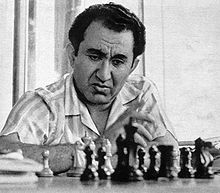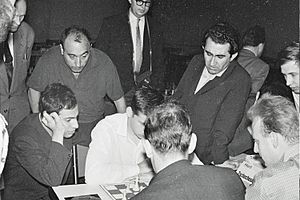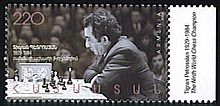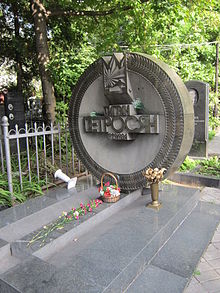
- Chess World Cup
- FIDE Grand Prix
- Olympiad
- World Championship
- List of strong tournaments
- List of world championships

- Checkmate patterns
- Chess openings
- Chess strategy
- Chess tactics
- Chess theory
- Endgames
- Pawn structure
- Problems/Compositions













Tigran Petrosian in 1975
|
|
| Full name | Tigran Vartanovich Petrosian |
|---|---|
| Country | Soviet Union |
| Born | June 17, 1929 Tiflis, Georgian SSR, Soviet Union (present-day Tbilisi, Georgia) |
| Title | Grandmaster (1952) |
| World Champion | 1963-69 |
| Peak rating | 2645 (July 1972) |
Tigran Vartanovich Petrosian (Russian: Тигра́н Варта́нович Петрося́н; Armenian: Տիգրան Պետրոսյան; June 17, 1929 - August 13, 1984) was a Soviet Armenian Grandmaster, and World Chess Champion from 1963 to 1969. He was nicknamed "Iron Tigran" due to his almost impenetrable defensive playing style, which emphasised safety above all else.
Petrosian was a Candidate for the World Championship on eight occasions (1953, 1956, 1959, 1962, 1971, 1974, 1977 and 1980). He won the World Championship in 1963 (against Mikhail Botvinnik), successfully defended it in 1966 (against Boris Spassky), and lost it in 1969 (to Spassky). Thus he was the defending World Champion or a World Championship Candidate in ten consecutive three-year cycles. He won the Soviet Championship four times (1959, 1961, 1969, and 1975).
Petrosian is widely known for popularizing chess in Armenia. He was recognized as the hardest player to beat in the history of chess by the authors of a 2004 book.
Petrosian was born to Armenian parents on June 17, 1929 in Tiflis, Georgian SSR (modern-day Georgia). As a young boy, Petrosian was an excellent student and enjoyed studying, as did his brother Hmayak and sister Vartoosh. He learned to play chess at the age of 8, though his illiterate father Vartan encouraged him to continue studying, as he thought chess was unlikely to bring his son any success as a career. Petrosian was orphaned during World War II and was forced to sweep streets to earn a living. It was about this time that his hearing began to deteriorate, a problem that afflicted him throughout his life. In a 1969 interview with Time magazine, he recalled:
He used his rations to buy Chess Praxis by Danish grandmaster Aron Nimzowitsch, a book which Petrosian would later claim to have had the greatest influence on him as a chess player. He also purchased The Art of Sacrifice in Chess by Rudolf Spielmann. The other player to have had an early effect on Petrosian's chess was José Raúl Capablanca. At 12 years old, he began training at the Tiflis Palace of Pioneers under the auspices of Archil Ebralidze. Ebralidze was a supporter of Nimzowitsch and Capablanca, and his scientific approach to chess discouraged wild tactics and dubious combinations. As such, Petrosian developed a repertoire of solid positional openings, such as the Caro-Kann Defence. After training at the Palace of Pioneers for just one year, he defeated visiting Soviet grandmaster Salo Flohr at a simultaneous exhibition.
By 1946, Petrosian had earned the title of Candidate Master. In that year alone, he drew against Grandmaster Paul Keres at the Georgian Chess Championship, then moved to Yerevan where he won the Armenian Chess Championship and the USSR Junior Chess Championship. Petrosian earned the title of Master during the 1947 USSR Chess Championship, though he failed to qualify for the finals. He set about to improve his game by studying Nimzowitsch's My System and by moving to Moscow to seek greater competition.
 Petrosian (standing on right, with jacket) at the 1961 European Chess Team Championship. Seated, facing right, is Mikhail Tal, then world champion.
Petrosian (standing on right, with jacket) at the 1961 European Chess Team Championship. Seated, facing right, is Mikhail Tal, then world champion.After moving to Moscow in 1949, Petrosian's career as a chess player advanced rapidly and his results in Soviet events steadily improved. He placed second in the 1951 Soviet Championship, thereby earning the title of international master. It was in this tournament that Petrosian faced world champion Botvinnik for the first time. Playing White, after obtaining a slightly inferior position from the opening, he defended through two adjournments and eleven total hours of play to obtain a draw. Petrosian's result in this event qualified him for the Interzonal the following year in Stockholm. He earned the title of Grandmaster by coming in second in the Stockholm tournament, and qualified for the 1953 Candidates Tournament.
Petrosian placed fifth in the 1953 Candidates Tournament, a result which marked the beginning of a somewhat stagnant period in his career. He seemed content drawing against weaker players and maintaining his title of Grandmaster rather than improving his chess or making an attempt at becoming World Champion. This attitude was illustrated by his result in the 1955 USSR Championship: out of 19 games played, Petrosian was undefeated, but won only four games and drew the rest, with each of the draws lasting twenty moves or less. Although his consistent playing ensured decent tournament results, it was looked down upon by the public and by Soviet chess media and authorities. Near the end of the event, journalist Vasily Panov wrote the following comment about the tournament contenders: "Real chances of victory, besides Botvinnik and Smyslov, up to round 15, are held by Geller, Spassky and Taimanov. I deliberately exclude Petrosian from the group, since from the very first rounds the latter has made it clear that he is playing for an easier, but also honourable conquest - a place in the interzonal quartet."
This period of complacency ended with the 1957 USSR Championship, where out of 21 games played, Petrosian won seven, lost four, and drew the remaining 10. Although this result was only good enough for seventh place in a field of 22 competitors, his more ambitious approach to tournament play was met with great appreciation from the Soviet chess community. He went on to win his first USSR Championship in 1959, and later that year in the Candidates Tournament he defeated Paul Keres with a display of his often-overlooked tactical abilities. Petrosian was awarded the title of Master of Sport of the USSR in 1960, and won a second Soviet title in 1961. His excellent playing continued through 1962 when he qualified for the Candidates Tournament for what would be his first World Championship match.
Read main article: World Chess Championship 1963
After playing in the 1962 Interzonal in Stockholm, Petrosian qualified for the Candidates Tournament in Curaçao along with Pal Benko, Miroslav Filip, Bobby Fischer, Efim Geller, Paul Keres, Viktor Korchnoi, and Mikhail Tal. Petrosian, representing the Soviet Union, won the tournament with a final score of 17½ points, followed by fellow Soviets Geller and Keres each with 17 points and the American Fischer with 14. Fischer later accused the Soviet players of arranging draws and having "ganged up" on him to prevent him from winning the tournament. As evidence for this claim, he noted that all 12 games played between Petrosian, Geller, and Keres were draws. Statisticians pointed out that when playing against each other, these Soviet competitors averaged 19 moves per game, as opposed to 39.5 moves when playing against other competitors. Although responses to Fischer's allegations were mixed, FIDE later adjusted the rules and format to try to prevent future collusion in the Candidates matches.
Having won the Candidates Tournament, Petrosian earned the right to challenge Mikhail Botvinnik for the title of World Chess Champion in a 24-game match. In addition to practicing his chess, Petrosian also prepared for the match by skiing for several hours each day. He believed that in such a long match, physical fitness could become a factor in the later games. This advantage was increased by Botvinnik being much older than Petrosian. Whereas a multitude of draws in tournament play could prevent a player from taking first place, draws did not affect the outcome of a one-on-one match. In this regard, Petrosian's cautious playing style was well-suited for match play, as he could simply wait for his opponent to make mistakes and then capitalize on them. Petrosian won the match against Botvinnik with a final score of 5 to 2 with 15 draws, securing the title of World Champion.
Upon becoming World Champion, Petrosian campaigned for the publication of a chess newspaper for the entire Soviet Union rather than just Moscow. This newspaper became known as 64. Petrosian studied for a degree of Master of Philosophical Science at Yerevan State University; his thesis, dated 1968, was titled "Chess Logic, Some Problems of the Logic of Chess Thought".
Three years after Petrosian had earned the title of World Chess Champion, he was challenged by Boris Spassky. Petrosian successfully defended his title, a feat that had not been accomplished since Alexander Alekhine defeated Efim Bogoljubov in the 1934 World Championship. However, Spassky would defeat Efim Geller, Bent Larsen and Viktor Korchnoi in the next candidates cycle earning a rematch with Petrosian, at Moscow 1969. Spassky won the match by 12½-10½.
 To commemorate the 75th anniversary of his birth, the Republic of Armenia issued this 220 dram stamp on February 25, 2005.
To commemorate the 75th anniversary of his birth, the Republic of Armenia issued this 220 dram stamp on February 25, 2005.Along with a number of other Soviet chess champions, he signed a petition condemning the actions of the defector Viktor Korchnoi in 1976. It was the continuation of a bitter feud between the two, dating back at least to their 1974 Candidates semifinal match in which Petrosian withdrew after five games while trailing 3½-1½ (+3 −1 =1). His match with Korchnoi in 1977 saw the two former colleagues refuse to shake hands or speak to each other. They even demanded separate eating and toilet facilities. Petrosian went on to lose the match and was subsequently fired as editor of Russia's largest chess magazine, 64. His detractors condemned his reluctance to attack and some put it down to a lack of courage. At this point however, Botvinnik spoke out on his behalf, stating that he only attacked when he felt secure and his greatest strength was in defence.
Some of his late successes included victories at Lone Pine 1976 and in the 1979 Paul Keres Memorial tournament in Tallinn (12/16 without a loss, ahead of Tal, Bronstein and others), shared first place (with Portisch and Hübner) in the Rio de Janeiro Interzonal the same year, and second place in Tilburg in 1981, half a point behind the winner Beliavsky. It was here that he played his last famous victory, a miraculous escape against the young Garry Kasparov.
 Petrosian's statue near the Yerevan Chess House
Petrosian's statue near the Yerevan Chess HousePetrosian died of stomach cancer in 1984 in Moscow and is buried in the Moscow Armenian Cemetery. In 1987, World Chess Champion Garry Kasparov unveiled a memorial at Petrosian's grave which depicts the laurel wreath of World Champion and an image contained within a crown of the sun shining above the twin peaks of Mount Ararat - the national symbol of Petrosian's Armenian homeland. On 7 July 2006, a monument honoring Petrosian was opened in the Davtashen district of Yerevan, in the street named after Petrosian.
Petrosian was not selected for the Soviet Olympiad side until 1958; he had already been a Candidate twice by that time. But he then made ten straight Soviet Olympiad teams from 1958 to 1978, won nine team gold medals, one team silver medal, and six individual gold medals.
His overall performance in Olympiad play is impressive: +78 −1 =50 (only one game lost, to Robert Hübner, out of 129 played), for 79.8 per cent, the third all-time best performance after Mikhail Tal and Anatoly Karpov. His Olympiad results follow.
 Tigran Petrosian's Grave
Tigran Petrosian's GravePetrosian also made the Soviet team for the first eight European Team Championships (from 1957 to 1983). He won eight team gold medals, and four board gold medals. His totals in Euroteams play, according to olimpbase.org, are (+15 −0 =37), for 64.4 per cent. His Euroteams results follow.
Petrosian was a conservative, cautious, and highly defensive chess player who was strongly influenced by Aron Nimzowitsch's idea of prophylaxis. He made more effort to prevent his opponent's offensive capabilities than he did to make use of his own. He very rarely went on the offensive unless he felt his position was completely secure. He usually won by playing consistently until his aggressive opponent made a mistake, securing the win by capitalizing upon this mistake without revealing any weaknesses of his own. This style of play often led to draws, especially against other players who preferred to counterattack. Nonetheless, his patience and mastery of defence made him extremely difficult to beat. He was undefeated at the 1952 and 1955 Interzonals, and in 1962 he did not lose a single tournament game. Petrosian's consistent ability to avoid defeat earned him the nickname "Iron Tigran".
Petrosian preferred to play closed openings that did not commit his pieces to any particular plan. As black, Petrosian enjoyed playing the Sicilian Defence, Najdorf Variation and the French Defence. As white, he often played the English Opening. Petrosian would often move the same piece multiple times in a few moves, confusing his opponents in the opening and threatening draws by threefold repetition in the endgame. In a game against Mark Taimanov during the 1955 USSR Chess Championship, Petrosian moved the same rook 6 times in a 24-move game, with 4 of those moves occurring on consecutive turns. He had a strong affinity for knights rather than bishops, a characteristic that is attributed to the influence of Aron Nimzowitsch.
A number of illustrative metaphors have been used to describe Petrosian's style of play. Harold C. Schonberg said that "playing him was like trying to put handcuffs on an eel. There was nothing to grip." He has been described as a centipede lurking in the dark, a tiger looking for the opportunity to pounce, a python who slowly squeezes his victims to death, and as a crocodile who waits for hours to make a decisive strike. Boris Spassky, who would succeed Petrosian as World Chess Champion, described his style of play as such: "Petrosian reminds me of a hedgehog. Just when you think you have caught him, he puts out his quills."
Petrosian's style of play, although highly successful for avoiding defeats, was criticized as being dull. Chess enthusiasts saw his "ultraconservative" style as an unwelcome contrast to the popular image of Soviet chess as "daring" and "indomitable". His 1971 Candidates Tournament match with Viktor Korchnoi featured so many monotonous draws that the Russian press began to complain. However, Svetozar Gligorić described Petrosian as being "very impressive in his incomparable ability to foresee danger on the board and to avoid any risk of defeat." Petrosian responded to his criticisms by saying "They say my games should be more 'interesting'. I could be more 'interesting' - and also lose." Petrosian was, in the words of future World Champion Vladimir Kramnik, "the first defender with a capital D".
Despite his reputation as a dull player, however, Petrosian would occasionally play in an attacking, sacrificial style. He would often do this as a psychological ploy to unsettle opponents. In his 1966 match with Spassky, he won Game 7 and Game 10 this way. Boris Spassky subsequently stated: "It is to Petrosian's advantage that his opponents never know when he is suddenly going to play like Mikhail Tal." (Tal was known as the most aggressive attacker of his era).
| a | b | c | d | e | f | g | h | ||
| 8 |

                        |
8 | |||||||
| 7 | 7 | ||||||||
| 6 | 6 | ||||||||
| 5 | 5 | ||||||||
| 4 | 4 | ||||||||
| 3 | 3 | ||||||||
| 2 | 2 | ||||||||
| 1 | 1 | ||||||||
| a | b | c | d | e | f | g | h | ||
Petrosian was known for his use of the "positional exchange sacrifice", where one side sacrifices a rook for the opponent's bishop or knight. Kasparov discussed Petrosian's use of this motif:
One of Petrosian's most famous examples of the positional exchange sacrifice is from his game against Samuel Reshevsky in Zurich 1953. Reshevsky, playing white, appears to have an advantage due to his strong pawn center, which may become mobile after Bf3 and d4-d5. Petrosian realized he was in a difficult position because of the passive placement of his pieces, relegated to defensive roles. He further understood that White might also advance on the kingside with h2-h4-h5, provoking weaknesses that would make it more difficult to defend later on. Faced with these threats, Petrosian devised a plan to maneuver his knight to the square d5, where it would be prominently placed in the center, and blockade the advance of White's pawns.
With the rook vacated from e7, the black knight is free to move to d5, where it will be attacking the pawn on c3, and help support an eventual advance of his queenside pawn majority with b5-b4.
The game was eventually drawn on move 41.
| a | b | c | d | e | f | g | h | ||
| 8 |

                                |
8 | |||||||
| 7 | 7 | ||||||||
| 6 | 6 | ||||||||
| 5 | 5 | ||||||||
| 4 | 4 | ||||||||
| 3 | 3 | ||||||||
| 2 | 2 | ||||||||
| 1 | 1 | ||||||||
| a | b | c | d | e | f | g | h | ||
Petrosian was an expert against the King's Indian Defence, and he often played what is now known as the Petrosian System: 1.d4 Nf6 2.c4 g6 3.Nc3 Bg7 4.e4 d6 5.Nf3 0-0 6.Be2 e5 7.d5. This variation closes the center early in the game. One of the tactical ideas for White is to play Bg5, pinning Black's knight to his queen. Black can respond by either moving his queen (usually ...Qe8) or by playing ...h6, though the latter move weakens Black's kingside pawn structure. Two of Black's responses to the Petrosian Variation were developed by grandmasters Paul Keres and Leonid Stein. The Keres Variation arises after 7...Nbd7 8.Bg5 h6 9.Bh4 g5 10.Bg3 Nh5 11.h4, and the Stein Variation begins an immediate queenside offensive with 7...a5.
The Queen's Indian Defence also has a variation developed by Petrosian: 1.d4 Nf6 2.c4 e6 3.Nf3 b6 4.a3, with the idea of preventing ...Bb4+. This system received much attention in 1980 when it was used by the young Garry Kasparov to defeat several grandmasters. Today the Petrosian Variation is still considered the most pressing variation, with the greatest score in Master games.
Other Petrosian variations can be found in the Grünfeld Defence after 1.d4 Nf6 2.c4 g6 3.Nc3 d5 4.Nf3 Bg7 5.Bg5, and the French Defence after 1.e4 e6 2.d4 d5 3.Nc3 Bb4 4.e5 Qd7. Some authorities refer to a variation of the Caro-Kann Defence with his name, along with former World Champion Vassily Smyslov: the Petrosian-Smyslov Variation, 1.e4 c6 2.d4 d5 3.Nc3 dxe4 4.Nxe4 Nd7.
Petrosian was partially deaf and wore a hearing aid during his matches, which sometimes led to strange situations. On one occasion he offered a draw to Svetozar Gligorić, which Gligorić initially refused in surprise, but then changed his mind in a few seconds and re-offered the draw. However, Petrosian did not even respond, instead went ahead and won the game. As it later turned out, he switched off his hearing aid, and did not hear when Gligorić re-offered the draw. In 1971, he played a candidates match against Robert Hübner in a noisy area in Seville, which did not disturb him, but frustrated Hübner so much that he finally withdrew from the match.